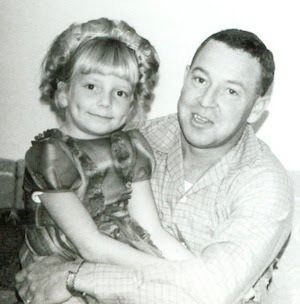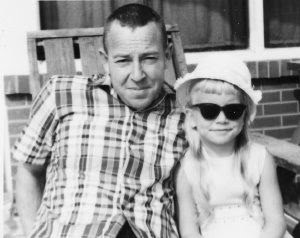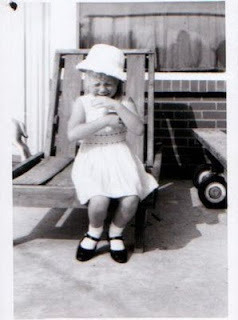Teresa Medeiros's Blog, page 2
November 26, 2011
Aunt Doris's Hash Brown Casserole Recipe
 Here's a yummy recipe for Hash Brown Casserole my Aunt Doris gave me when we got married.
Here's a yummy recipe for Hash Brown Casserole my Aunt Doris gave me when we got married. WARNING: It contains not one, but TWO sticks of butter, which is why we only make it at Thanksgiving and Christmas. But it's worth every calorie! :)
INGREDIENTS
1 8 oz sour cream
1 can Campbell's Cream of Chicken soup
2 melted sticks of butter (melt each stick separately)
1 cup grated sharp cheddar cheese
2 lb bag frozen hash browns (O'Brien style) (Thaw before using)
Box of crushed Cornflakes
1) Put thawed hash browns in 9 X 13 pan
2) Mix rest of ingredients and pour over top, including only ONE stick of the butter
3) Top with crushed cornflakes
4) Pour the other melted stick of butter on top of the cornflakes
5) Bake at 350 degrees 45-60 minutes
(You can also include some chopped green pepper and 1/2 cup chopped onion if you're so inclined)
November 6, 2011
Coconut-Pecan Frosting (for German Chocolate Cake)

I am of the opinion that one should never put store-bought Coconut-Pecan Frosting on a German Chocolate cake. This recipe is absolutely scrumptious and fairly simple to make from scratch. Every year I make Hubby a birthday cake with this and he adores it. (And me! ;))
INGREDIENTS1 cup evaporated milk1 cup sugar3 slightly beaten egg YOLKS½ cup butter1 teaspoon vanilla1 1/3 cups Angel Flake Coconut1 cup chopped pecansCombine 1 cup evaporated milk, 1 cup sugar, 3 slightly beaten egg YOLKS, ½ cup butter and 1 teaspoon vanilla. Cook and stir over medium heat until thickened, about 12 minutes.Add 1 1/3 Baker's Angel Flake Coconut and 1 cup chopped pecans.Cool until thick enough to spread, beating occasionally. Makes enough to frost one cake. (Best to frost tops and let a little drizzle down the sides.)
I am of the opinion that one should never put store-bough...

I am of the opinion that one should never put store-bought Coconut-Pecan Frosting on a German Chocolate cake. This recipe is absolutely scrumptious and fairly simple to make from scratch. Every year I make Hubby a birthday cake with this and he adores it. (And me! ;))
Coconut-Pecan Frosting (for German Chocolate Cake)
INGREDIENTS1 cup evaporated milk1 cup sugar3 slightly beaten egg YOLKS½ cup butter1 teaspoon vanilla1 1/3 cups Angel Flake Coconut1 cup chopped pecans
Combine 1 cup evaporated milk, 1 cup sugar, 3 slightly beaten egg YOLKS, ½ cup butter and 1 teaspoon vanilla. Cook and stir over medium heat until thickened, about 12 minutes.
Add 1 1/3 Baker's Angel Flake Coconut and 1 cup chopped pecans.
Cool until thick enough to spread, beating occasionally. Makes enough to frost one cake. (Best to frost tops and let a little drizzle down the sides.)
July 20, 2011
The Flame and the Flower: Revisiting a Romance Classic
I was ten years old when The Flame and the Flower was first published, fifteen the first time I read it. Although I read it numerous times after that, I hadn't picked it up in years. So when I started re-reading the book to research this article, I told myself I'd treat it like an assignment and just read for an hour at a time. The prose was denser and much more detailed than what we've become accustomed to in recent years, but after only a few pages, I found myself thoroughly captivated. Before I knew it, three hours had passed and I still couldn't bear to put the book down. Thirty years after it's publication, The Flame and the Flower is still a deliciously readable novel, a quality it shares with another timeless classic, Gone with the Wind.
I was also struck all over again by what a fine writer Kathleen E. Woodiwiss is. To enter her world is to enter a time machine that transports you back to 1799, where Heather Simmons, our Georgian Cinderella, is being held captive by her aunt's cruelty until sea captain Brandon Birmingham comes storming into her life to sweep her away. Although Woodiwiss's descriptions are lush and detailed, her prose is never purple. You can almost hear the ring of poetry in her description of Heather's uncle: His hands were gnarled and twisted with the years of backbreaking labor eking a shallow subsistence from the marshy land, and the weather-thickened skin held the pain of the passing seasons etched in deep lines that furrowed his face. And the clean, evocative beauty of this sentence, which describes Brandon's ship as it makes its way to the Americas, is enough to make any writer in any genre weep with envy: Now the rigging sang in the wind and the ship strained as it chopped its way through frothy white caps. By setting her own standards so high, Woodiwiss challenged every romance writer who came after her to strive for excellence in their craft.
One of the criteria of an enduring classic is that it should be the first to do something, and in The Flame and the Flower, Woodiwiss succeeds on every count. So many of her innovations would go on to become the bedrock conventions upon which the historical romance genre would be grounded. Although her settings and secondary characters are vividly drawn, the relationship between Heather and Brandon always remains at the core of the plot. By trapping them together on an arduous sea voyage for much of the book, Woodiwiss succeeds in creating the perfect romantic microcosm. Many scenes that might seem clichéd now were sparkling and new thirty years ago: the heroine assisting the hero with his bath; the hero walking in on the heroine as she bathes; the hero nursing the heroine through a near fatal illness caused by his own insensitivity. Woodiwiss gives the hero a loveable wise-quipping brother, a loyal manservant, and a witchy ex-fiancée.
Every man who meets Heather falls a little bit in love with her and in an eerily prescient twist, there's even a suspense sub-plot involving a brutal killer that drives the book to a heart-jolting climax.
Although less politically correct then some would prefer, the book is probably more historically accurate than many of the romances written today where all the young misses are feisty and all the gents are enlightened as to the rights of women. Yes, seventeen-year-old Heather is essentially a passive victim in the beginning and thirty-five-year-old Brandon is perfectly capable of being an arrogant jerk, but they both fulfill that essential criteria of good fiction—they experience personal growth and transformation during the course of the story. Heather finds her spirit while Brandon loses his heart.
Whether it be on Amazon.com or on a panel with other romance writers, you can't discuss this book or Heather and Brandon's first sexual encounter without waging the same debate that's been raging ever since Rhett carried a resisting Scarlet up those long, winding stairs in Gone with the Wind. I learned that firsthand in Harpers Ferry in April of 2002 when I had the pleasure of participating in a panel discussion comparing The Flame and the Flower to a "modern" romance. Some participants found the book enthralling while others found it appalling, but no matter what their opinion, it still evoked emotions every bit as strong as the passion Heather and Brandon share.
The controversy arises when, during their first meeting, a drunken Brandon mistakes Heather for a wharf prostitute. Both her explanations and her struggles are so weak and ineffectual that one can almost forgive him the mistake. He's quite remorseful when he realizes he's deflowered an innocent, but that doesn't stop him from taking her once more before she makes her escape. Is this shocking and wicked? Oh yes! But still stirring in this era where our deepest and most primal sexual fantasies have been sanitized and the definition of "feminism" seems to be have been extended to the area of censoring other women's fantasies. When Brandon tells Heather, "I've found with you, sweet, that when I want you badly enough I can overlook being a gentleman," my heart beats a little faster as I imagine him with the devilish glint of a marauding Errol Flynn or Clark Gable in his eye.
As Patricia Reynolds Smith, the academic who edited Dangerous Men and Adventurous Women with Jayne Ann Krentz, pointed out during our panel discussion, this is no forced seduction where Heather is made to experience pleasure against her will. Woodiwiss never once glamorizes rape. Heather despises it the two times Brandon has his way with her when she is resistive. It's not until he learns to show her tenderness and consideration after a long period of enforced abstinence that she comes to enjoy their lovemaking.
The one scene that fueled my own adolescent fantasies and has lingered in my imagination for over twenty-four years is the scene where Brandon first learns that Heather is carrying his child. After her vicious aunt slaps her and rips her ragged dress from her body, revealing her pregnant nakedness to everyone in the room, Brandon comes storming out of the shadows and sweeps his cloak around her. In that one thrilling and protective gesture, we see a shadow of the hero he will become.
Although Brandon can be a bit of a bully when crossed, from the very beginning of the novel he demonstrates a capacity for humor and irresistible kindness. He resents being forced into marriage, yet he buys Heather beautiful clothes, covers her when she is cold, has a tub brought on board his ship because he knows she cherishes her baths, and orders a special pair of long johns made to help her endure the bitter winter weather at sea. He also fulfills another crucial female fantasy that would go on to become a staple of our genre—once he lays eyes on Heather, he never wants or touches another woman.
Since The Flame and the Flower gave women their first chance to read about sex outside of the context of male pornography, I was amazed to realize how few sex scenes there actually are in the book. After Heather and Brandon's initial encounter, they don't make love again until near the very end of the novel. During the long sea voyage, we watch them slowly becoming husband and wife—denying each other sexual comforts, yet strengthening their emotional bond. We enjoy the vicarious thrill of watching them fall in love, not just in lust.
The sensual tension escalates through a series of tender moments such as the one where they exchange Christmas gifts back at Brandon's Carolina plantation, the scene where Heather is sewing baby clothes while Brandon reads aloud to her from A Midsummer Night's Dream, and the funny and touching scene where their child is finally born. By the end of the book, you actually believe that these two could build a happy life together—built not only on physical attraction, but on mutual respect and love.
While Brandon is becoming a hero worth having, Heather completes her own satisfying personal journey. Her fiery confrontations with her husband don't defeat her, but strengthen her. No longer a passive victim, late in the book she even vanquishes the lecherous Mr. Bartlett, who manhandles her when he mistakes her for a bondwoman. While devoted slave Hatti hits the villain in the face with a mop, Heather stomps on his instep, then hurls a chunk of soap at his head, causing him to somersault off the porch. A fuming Brandon arrives, but Heather no longer needs him to rescue her. She has completed her journey from girl to woman and is now fully his equal and his match.
Both the power and pleasure of The Flame and the Flower are rooted in its retelling of the primal myths that reside in our collective unconsciousness. In the snippet of poetry that prefaces the book, it is not the flame that consumes the flower, but the flower that triumphs by re-emerging after being scorched by the flame. Kathleen E. Woodiwiss didn't just understand the "Beauty and the Beast" mythology on an intellectual level. She internalized it to such a degree that it infuses every word of both this story and her follow-up classic, The Wolf and the Dove.
And in Brandon Birmingham, Woodiwiss delivers a beast worthy of the taming. As Patricia Reynolds Smith pointed out during our panel discussion, in recent years there has been a tendency for romance writers to "defang" their beasts much too early in our stories. We're so determined to make our protagonists "heroic" from the very first page (possibly to stave off internet criticism of the ultra-Alpha male?) that there's very little room left for the personal growth that makes this book so satisfying and enduring.
And it is enduring. 183 reader reviews on Amazon.com prove that. As I scrolled through them, I was amazed by how many of them were written by girls who were around the same age I was when I first discovered the book. It seemed these young women could relate to both Heather's age and her coming-of-age journey during the story. This made me wonder if romance writers aren't missing some vital component of "growing the market" in our efforts to be more politically correct by prematurely aging the heroines in our historical romances. Perhaps the best way to win a reader's heart for life is to win it while it's still young and tender.
Whether you love The Flame and the Flower or hate it, we're still talking about it almost 40 years later. How many other romances will be able to make that claim? As I turned the last page of the book with a wistful sigh, I was humbled all over again by what a tremendous debt of gratitude we all owe Kathleen E. Woodiwiss. Brandon Birmingham and Heather Simmons are truly the grandparents of all the historical heroes and heroines who came after them. At the end of the book, Kathleen E. Woodiwiss shouldn't have written The End, but The Beginning.
February 10, 2011
SAY IT LOUD AND SAY IT PROUD: I READ AND WRITE ROMANCE!

I could spend hours sharing all of my passionate arguments on the benefits of both reading and writing romance. I could quote more market statistics. I could quote psychologists. I could quote Jayne Ann Krentz and remind you of the positive, life-affirming values inherent in all romances: the celebration of female power, courage, intelligence, and gentleness; the inversion of the power structure of a patriarchal society; the psychological benefits of spending time with authors who have a positive world view.
But to be honest I'm a little sick of defending "romance" as a genre to people too obsessed with its sexual content to attempt to understand its emotional content. So if any of you are ever leered at, sneered at, or otherwise degraded for writing or reading romance, simply blink and gently say (really quickly), "What the romance novel is really all about is the archetypal human struggle of integrating the masculine and feminine aspects of our psyches." I can promise you that nothing will shut them up faster.
People often ask me why I write romance. I write romance because the ever expanding boundaries of the genre allow me to express my own heartfelt beliefs in optimism, faith, honor, chivalry and the timeless power of love to provoke a happy ending. In a society gutted by cynicism, we have found the courage to stand up and proclaim that hope isn't corny, love isn't an antiquated fantasy, and dreams can come true for women still willing to strive for them.
Probably the most subversive thing we dare to do is to make the woman the hero of her own story. And to realize exactly how subversive that is, I want each of you to honestly ask yourselves if the marvelous J.K. Rowling would have been such an international success if her first book had been titled, HARRIET POTTER AND THE SORCERER'S STONE. Traditionally, in our mainstream patriarchal society, it's been the male character who is allowed to go on all the thrilling physical and emotional quests. Oh, he might have a female sidekick like the delightful Hermione Granger in HARRY POTTER, but she is rarely allowed to overstep her role as confidante and facilitator of his self-discovery. In a romance, the heroine acts as narrator of her own story as well as driving the various plotlines that fuel that story.
Our heroines don't just "stand by their men", they "stand up to them." And guess what—their men love it! We celebrate both a woman's softness and her strength and introduce her to a man capable of recognizing the value of both. Is it any wonder that both she and our readers fall in love with him?
I write romance because a young woman in Portugal named Lourdes Goulart was praying that my next book would come out before the cancer that was ravaging her body claimed her life. Even though chemotherapy had weakened her eyesight to the point of blindness, she sent me a beautiful and painstaking cross-stitch she'd done of a windmill she could see through the window from her bed. Six months ago, I received word from her sister, Rosa, that Lourdes had died. She started my new book the day before she entered the hospital for the last time, but didn't want to read past the first page for fear of being interrupted.
I write romance because of a call I recently received from a friend who attended nursing school with me. She'd just undergone a total hysterectomy. She described how depressed and emotionally empty she'd felt after the surgery and its numerous complications. She told me that reading my latest book pulled her out of her depression and even restored the sexual desire for her husband that she had feared she would never feel again.
I write romance because of an e-mail I recently received from a 54-year old incest survivor. Instead of blaming her father for the terrible thing he had done to her, she had always blamed her mother for letting him do it. Because my hero in A KISS TO REMEMBER found the grace in his soul to forgive his mother for a similar act, this woman decided, after nursing her bitterness for 50 years, to forgive her mother before she passed away from Alzheimer's Disease.
I'd like to share one more brief story with you:
They met in 1957 when he was twenty-two and she was eighteen. He was a skinny, handsome G.I. with a motorcycle and a devilish twinkle in his eye. She was his sister's best friend. She was beautiful, smart, and funny. He was in love.
They married in 1959 and three years later, while she was pregnant with what was to be their first and only child, he was transferred to Heidelburg, Germany. They lived over a bakery run by a jovial German couple named "Momma and Poppa Hartman." On weekends, they would climb into his convertible MG without so much as a change of underwear and go racing through the countryside to explore the castles of Germany and Austria.
The child was born in 1962. His first indication that something was wrong was when he came home from work one day to discover that his wife had given away all the furniture. Luckily, a kind-hearted neighbor had taken it in and stored it in her apartment. His beautiful young wife lost weight and stopped sleeping. Her speech was rapid and slurred. At times, she even seemed to forget that she had given birth to a baby. He had no choice but to seek professional help.
The doctors informed him that his wife was suffering from a severe form of mental illness. It would be well over a decade before that illness was correctly diagnosed as Bipolar disorder or manic-depressive illness.
He went driving along the river that dark, rainy night at nearly a hundred miles an hour--a 26 year old soldier in a foreign country with a brand new baby and a wife facing a lifetime of torturous illness and uncertainty. He had a choice to make. He could shuffle his baby off to be raised by relatives and abandon his wife to the care of a German mental institution. He could drive into that river and let all of his decisions be made for him. Or he could choose to live and fight for his family.
My parents celebrated their 50th wedding anniversary this year. Because my dad meant it when he said, "for better or worse; in sickness and in health," I enjoyed a relatively stable, happy childhood and my mom's hospitalizations were kept to a minimum. My father's love is as unwavering and unconditional today as it was fifty-one years ago. Although my mother is now suffering from a rare and terminal brain disorder that has resulted in severe dementia, when my father visits her in the nursing home every other day, he still sees that beautiful, brilliant girl who won his heart all those years ago.
So when people ask me, "Why do you write romance?", I can only reply, "How could I not?"
http://www.teresamedeiros.com
You can follow Teresa on Twitter at http://www.twitter.com/teresamedeiros and join her Facebook Page at: http://www.facebook.com/teresamedeirosfanpage
December 15, 2010
March 9, 2010
Teresa Medeiros's Favorite Guy Candy 2
It's he-e-e-e-ere! Just posted the worldwide debut of my GUY CANDY 2 vide on YouTube. It's a tough job but somebody has to do it! Oh, the sacrifices I made for you as I "auditioned" all of these applicants on my computer screen! Enjoy! ;) (And please share with your friends!)
February 8, 2010
Girls Really Do Want Fun--or distractions
Check out this hilarious video put together by BFF Connie Brockway featuring Connie, me and another BFF Eloisa James. My cat swore this footage had been destroyed but I should have known I couldn't trust Buffy the Mouse Slayer. At one point you can see her trying to "direct" me!
January 18, 2010
A Photographic Essay of Teresa's Early Career Years
 Having always had a tendency toward big hair, Teresa spent most of her childhood waiting for the 80's to arrive
Having always had a tendency toward big hair, Teresa spent most of her childhood waiting for the 80's to arrive Having given up on her dream of becoming a princess, Teresa hired her daddy to be her agent and waited for Hollywood to come calling
Having given up on her dream of becoming a princess, Teresa hired her daddy to be her agent and waited for Hollywood to come calling When...
When...
January 11, 2010
Teresa's Top 20 WRITE RIGHT Tips Just For You

Dear Friends,I've been sharing some of my favorite writing tips over on Twitter (http://www.twitter.com/teresamedeiros) for months now and thought I'd finally gather them all together in one place. Happy writing!
1) Don't give characters unpronounceable names. Unless you're German, umlauts are not your friend.2) Almost any sentence except "I am born" can be improved with revision.3) Don't fear adverbs but actions verbs are always better. Not "He walked slowly" but "He trudged..."4) It's the...



